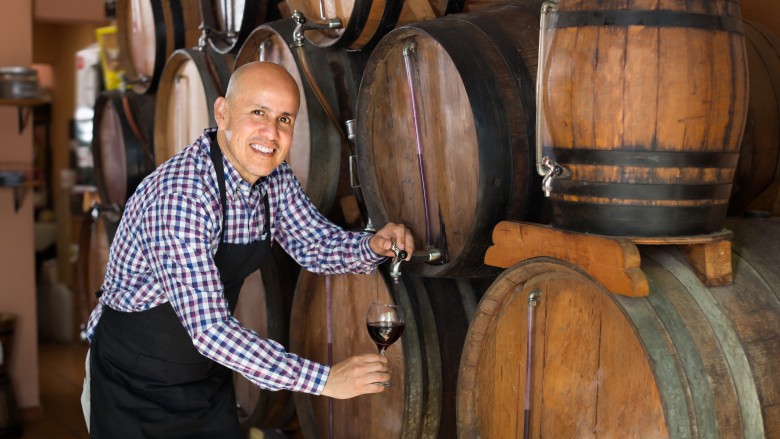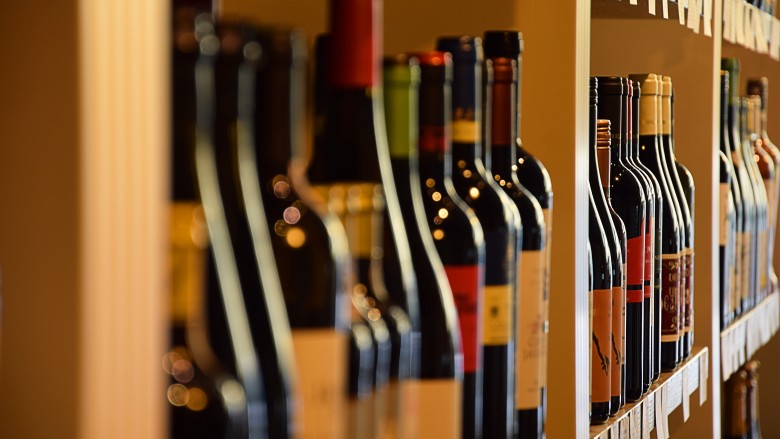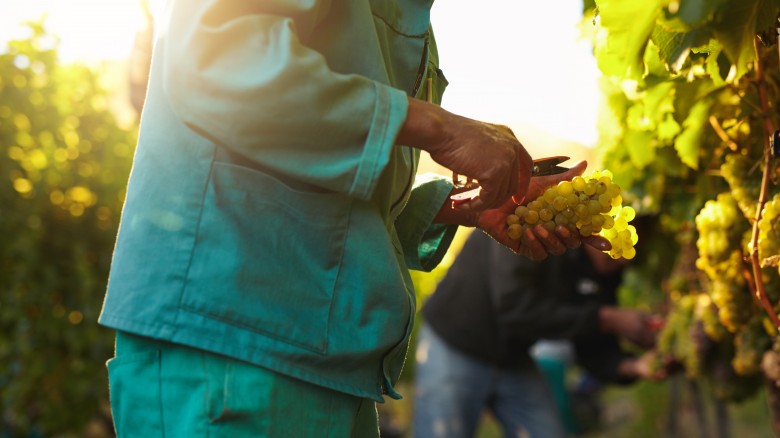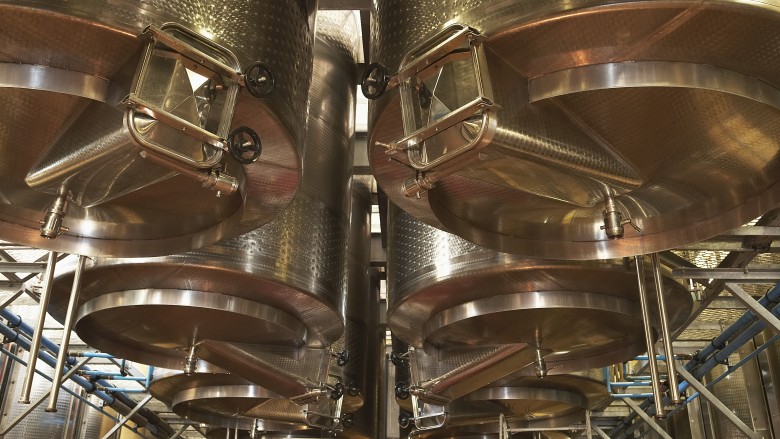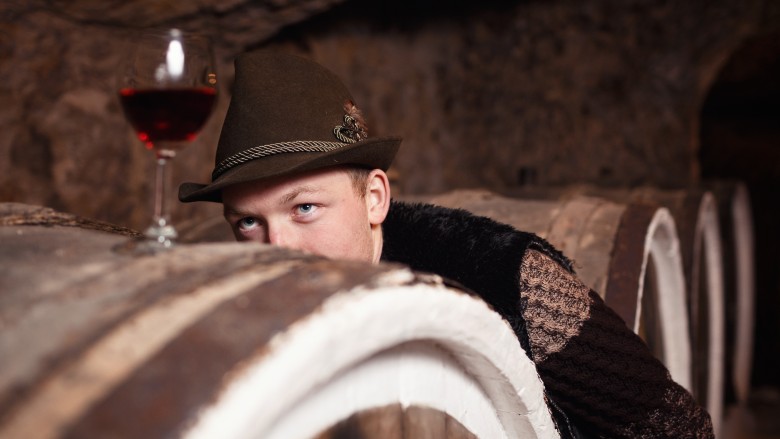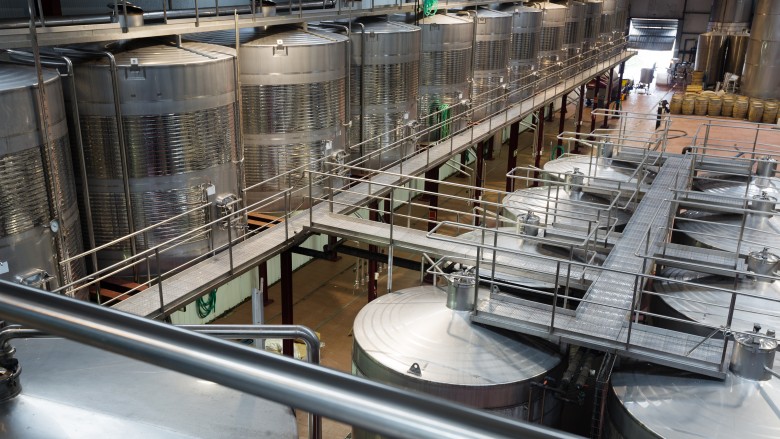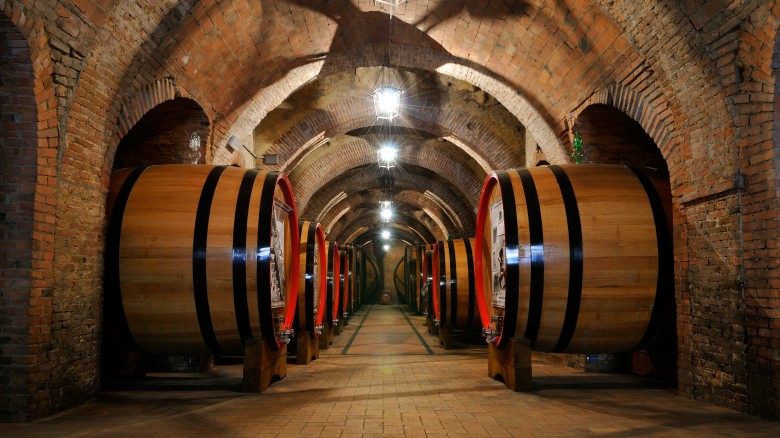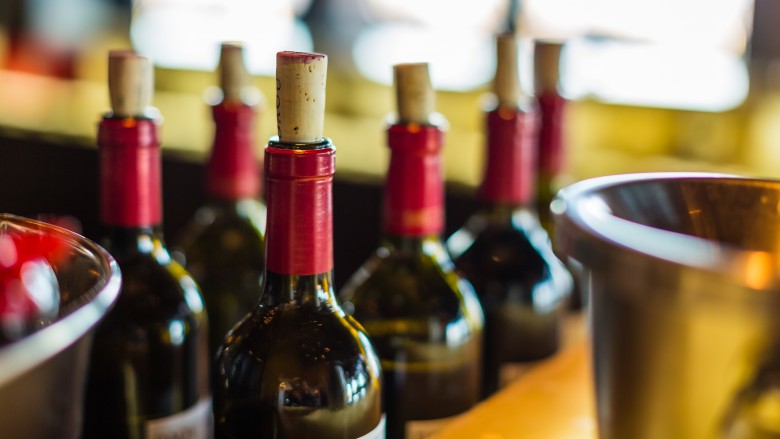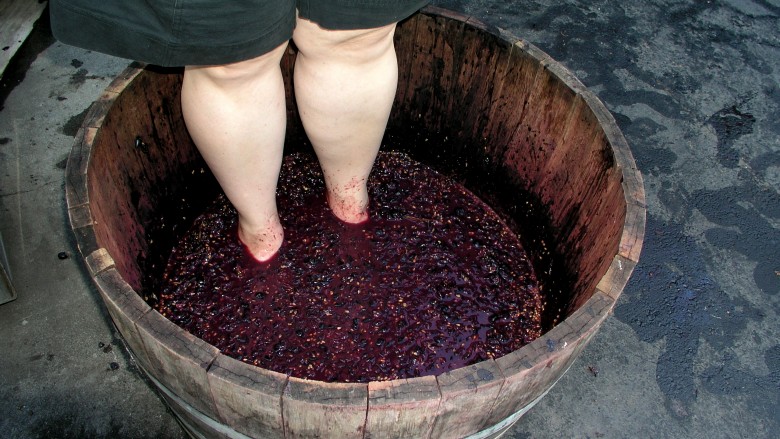The Untold Truth Of Wineries
Whether you're the type that has a go-to wine you gravitate toward, or you like to try something new every time you pick up a bottle, wine is essential for countless households. Even those that never drink it might pick up a bottle for a dinner party, and while we might think we know a lot about wine, how much do we know about wineries? There's a lot going on around the creation of your favorite bottle of vino, and some facts might change the way you think about wine forever.
The world's oldest winery has connections to burial and fertility rites
Wineries, tours, and tasting rooms are a go-to place for parties. The world's oldest winery, in Armenia, proves that's not a new tradition. The Areni-1 complex is a 6,100-year-old winery that was found inside a cave only 60 miles from Mount Ararat, which is the reported site of the world's first post-flood vineyard.
The discovery uncovered not only an ancient grape press, but the cave also contained fermenting vats, storage jars, cups, and the remains of grapes used by ancient wine-makers. They also found the oldest sample of intact brain tissue inside a skull in the cave, and historians think that it's a sign that wineries weren't just for making wine, they were places of ritual and sacrifice.
In 2015, Formaggio Kitchen got an unprecedented look inside the cave, and spoke to the archaeologist at the head of the excavation. Turns out, the winery was also the site of an agricultural ritual that saw people sacrificed and their blood added to the fermenting wine. The wine was then consumed right from the vat in some sort of communal ritual, likely thought to help ensure a prosperous harvest. It's dark stuff, for sure, but it goes to show just how important wineries have been to our very identity as a human race.
The initial investment is insane
Let's be honest, there's probably been more than a few Monday afternoons that you've dreamed about another life, one at the head of a winery where you can wander the vineyards and sample the finished product while you're outside in the summer sun. It's an amazing dream, for sure, but there's a huge catch: you already need to be at least a little bit rich.
William Foley is the head of the Foley Wine Group, and Forbes talked to him about getting started in the wine business. When he started talking costs, he started talking not even in terms of hundreds of thousands of dollars, but in millions.
Let's start at the very beginning of your investment, and that's in land. Everything from soil to climate is going to impact how your wine tastes, and if you're looking for the best land, you're looking at someplace like Napa Valley. There (and keep in mind that small vineyards are around five acres), you're looking at about $500,000 for a single acre. In other states, you might be able to pick up some suitable land for around $10,000 an acre, and that's still no small potatoes. Foley started out with a mind-blowing 460-acre, unplanted property, and he needed to build his production facilities from scratch. He said, "Before I knew it, I was into it for $15 million. It was like the blink of an eye. I didn't see it coming at all."
Factor in the idea that you're not going to start actually producing wine for anywhere from a few years to a decade, and you're going to need to keep that day job for a little while longer.
They get a pittance from that bottle you buy at the store
If you think you're supporting a winery by picking out one of their bottles, you're going to be shocked when you find out just how much they actually get from your purchase.
Let's take a bottle that costs between $28 and $30. Once you factor in the distributor's cut, how much the retailer takes, and production costs, the profit that the winery gets is, on average, somewhere around a single dollar.
Exact numbers are tough to come by, because most wineries are private companies and don't divulge their numbers. Some do go public with their numbers, though, and it's hugely valuable for the consumer to know not just why they're paying a particular price, but why it's so, so important to buy directly from a winery. When you do, you skip the retailer and the distributor, and the wineries get a lot more return on their product.
In 2014, Napa Valley's Chateau Montelena gave out some numbers, and said that for every $100 bottle of wine sold at a retailer, they got $19. It's not unique to retail stores, either. Say you get a bottle of wine at a restaurant, and you tip your waiter 10 percent of the price of that bottle. You're giving that waiter an average of five times what you're giving the winery, and that's why wineries put so much into their tasting rooms and on-site shops.
Most of the work is done by migrant workers
Every year, the wineries of Napa Valley ship millions of cases of wine all over the world, and most of the labor that produces those cases is migrant labor. From start to finish, wineries rely on thousands of migrant workers to do everything from prune vines to pick grapes, and that labor pool is so important to Napa Valley's wineries that they've put in place a program where wineries chip in for migrant food, housing, and even counseling services. The idea is to provide safe, comfortable, and sanitary housing for the workers that the entire industry depends on, and it hasn't always been like that.
It's not just Napa Valley that has an invaluable pool of migrant workers, either. In 2017, Virginia wineries — including (but not limited to) Trump Vineyard Estates — made headlines with their applications for visas that would allow them to bring workers to the East Coast and Blue Ridge Mountains from Mexico. And it's not unique to US wineries, either. In France, wineries make ends meet by hiring migrant workers, students, and retirees from all over to fill out their work force, while Spain's vineyards are filled with teams of migrant workers drawn from as far away as South America and Africa. Italy's wineries have made headlines, too, for the dire conditions that their migrant workers — often traveling over from Bulgaria, Romania, and Macedonia — are forced to live in. They're working the fields while sleeping on benches or in cars, and it's an incredibly hard life.
There are health risks associated with working there
When it comes to workplace risks, you might not think of a winery as being a particularly scary place, but it turns out wineries have occupational hazards that are similar to other agricultural jobs. According to the BC Medical Journal, the health risks of working in a winery range from asthma from exposure to the pesticides to the development of musculoskeletal disorders from hard, repetitive work. That's similar to some of the injuries and illnesses found in other agricultural work, but there are some things that are unique to wineries.
Confined spaces are a huge safety issue when it comes to wineries. Fermentation can create low-oxygen, high-CO2 areas, and that's an environment that can kill. OSHA's bulletin on confined space hazards in wineries says most of the concerns come from the wine tanks, which sometimes require workers to enter them. Forget to test the air, and it can suffocate.
There's another odd safety concern in wineries, too. There's a fairly high rate of dental problems in wine tasters and makers, and it comes from the repeated exposure to malic and tartaric acids present in wines. When your job requires tasting perhaps dozens of samples a day, your teeth are going to be subjected to some serious decalcification.
Wineries own their trade secrets, not the winemakers
You might think a winery is only as good as the skill of its master winemakers, and while that's true, a major restraint was placed on the wine industry in 1992. Prior to then, winemakers were regularly allowed to swap secrets, findings, and tips, and it's this free flow of information that was credited with creating entire communities of high-quality wineries, like those found in Napa Valley.
It all started when Kendall-Jackson sued one of its former winemakers, accusing the man of taking their trade secrets to another winery. While most of the details — like just what the trade secrets were and whether anyone else had used them — wasn't revealed in court, the end result was a ruling that it was the winemaker who was in the wrong. Since wineries now own their trade secrets, that's not only put a damper on a spirit of communication, but on a spirit that's helped US wineries compete with the European wineries that have had centuries to perfect their methods.
It's more industrialized than you want to imagine
There's a certain amount of romance to the wine industry, and we like to think the bottle we're enjoying was the product of a small — or large — operation that's fulfilling someone's dream of owning their own winery, working in the soil, and creating a finished product they're proud of. But pick up a bottle — or box — of your favorite affordable wine (and everyone has one), and you might be getting something that's more industrialized than you expect.
Business Insider took a look at the process that goes into making Trader Joe's most popular wine, Bronco Wine's Charles Shaw. Not only do they cut costs in less-than-perfect real estate, but they've also automated the entire process from harvesting grapes with machinery to making batches in 700,000-gallon tanks, which is massively more efficient than smaller batches. They're not the only ones that do it, either, and many of California's biggest wineries monitor their additives and chemicals with machinery that oversees million-gallon batches without the need to factor in the possibility of human error. There's more modern technology involved than you might expect, too: additives are used to change color to something more attractive to the consumer, wine is processed through a cone column that reduces alcohol content, and there's even a machine that speeds up the aging process by pushing oxygen bubbles through the tanks.
That oak flavor? They might be faking it
The idea of sampling a wine that's been aged in oak barrels to give it some distinctive notes might seem like another romantic idea to imagine when you're drinking your nightly glass, but the reality might just be a little different. Oak barrels are expensive, and wineries have found other ways to get that oak flavor without investing in actual oak barrels. Sometimes, oak shavings are added to the wine in order to impart that distinctive flavor, and that's only partially faking it — they're still using oak, after all.
There is, however, something called oak extract that's not just available for amateur winemakers, but that's also used by the big guys to tweak just how much oak flavor is in their wine. It's usually added in powder form after some pretty precise calculations on how much needs to be added for the right amount of oakiness in the final product, and that's something that seems a bit like cheating.
They're low-risk and historically not monitored closely
There was some major online outrage in 2014 after a Huffington Post article claimed that the industrialized process used by the Bronco Wine Company dumped everything from unripe grapes to animals into their wine. Bronco CEO Fred Franzia went on record saying that not only was that not true, but that the fermentation process wine underwent killed anything that might slip through the cracks — and that's important.
It's largely because of that process that wineries are considered low-risk as far as health safety issues are concerned, and that label has historically allowed them to operate without fear of the random health and safety checks that other food and drink producing operations are subject to. It wasn't until the 2011 Food Safety Modernization Act that state and federal inspections for wineries became something more regulated, and wineries became responsible for huge sections of the FDA rules and regulations they had previously been exempt from. While you might be tempted to think that the FDA has always been keeping a close eye on everything we eat and drink, that's absolutely not been the case with wineries.
Kosher wineries have a mind-boggling set of rules and regulations
Every spring, you'll start to hear about kosher wines hitting the shelf in preparation for Passover. Kosher wine is only produced by kosher wineries, and there's a huge list of rules and regulations in place for wineries that want to label their products as kosher, and if that winery is located in Israel, there are even more rules.
For wineries in Israel, there are rules about not only the use of only kosher ingredients (and even things like corks), but about leaving the land fallow every seven years. From crushing to bottling, only Sabbath-observant Jews are permitted to handle the wine.
Outside of Israel, there are kosher wineries these rules don't apply to, but some European wineries bring in observant Jews specifically for their production of kosher wine. If that all makes it sound like the whole thing is incredibly complicated, you're right. According to Zeev Smilansky, a winemaker in Israel, regulations are so closely monitored that barrels of wine that are even accidentally touched by a non-Jew can't be sold, as the wineries are forbidden from benefiting from even selling a non-kosher batch of wine. While a winery might use clear piping for their wine, kosher wineries might even go as far as making the pipes opaque so any Gentiles or non-Orthodox Jews don't even see the wine.
Yes, some wineries still make wine by foot
While many wineries have, by necessity, moved on to pressing methods that involve machinery, there are some wineries that still press their grapes the old-fashioned way: by foot. If you have a dislike of feet that means you might want to skip some Portuguese and Spanish wines, as it's their wineries that are most likely to still use foot treading as part of their process.
They're not the only ones, though, and there are some artisan wineries in the US that have grape stomping as a part of the process for making some of their select wines. Colin Alevras of the Red Hook Winery says this method still has a huge advantage over a more mechanized approach, and that it comes down to the seeds. If grape seeds are crushed in the process, they can add an astringent tingle to the finished product. Use foot treading, through, and there's not enough pressure to crush the seeds.
The practice of foot treading has held on for a surprisingly long time, especially considering one of the most iconic instances of it — Lucille Ball's dance through a barrel of grapes — was only done with the help of a winery that stipulated the show also say it wasn't common practice any more. It's no wonder, either, as if you're thinking the idea of foot wine is pretty cringe-worthy, you're not alone. The safety of it goes back to the fermentation process, though, and those that still do it are also quick to reassure their customers — and potential customers — that there's no danger of foot germs at all.

